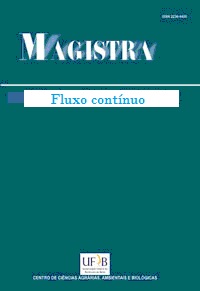Establishment of corn plants under different water regiments
Resumo
Abstract: The objective of this study was to identify the effect of water availability on corn plant growth. The study was carried out in greenhouse located at the State University of Goiás, Brazil, South-East Campus Ipameri. Four corn seeds 2A401P hybrid were planted in each polyethylene pot containing 8 kg substrate consisting of soil, sand and manure at the proportion of 3:1:1, respectively. A completely randomized design was used with six treatments and six replications. After emergence and initial development, the plants were irrigated with volumes of water corresponding to 0% (0ml), 25% (80 ml), 50% (160 ml), 100% (320 ml), 200% (640 ml) and 400% (1280 ml) of the daily crop evapotranspiration at 23 days after emergence. At 31 days after emergence the following variables were analyzed: number of leaves, plant height, stem diameter, total biomass, root mass ratio, stem mass ratio, leaf mass ratio, photosynthetic pigments, relative water content, transpiration rate and chlorophyll a fluorescence. Water shortage and flooding inhibited corn plant growth of 2A401P hybrid and thus damaged the establishment of the crop, but at different intensities, because water shortage was shown to be much more restrictive to plant growth than flooding. Furthermore, it is pointed out that corn plants are isohydric, because they anticipate water shortage by an efficient stomata sensitivity that controls water loss by transpiration. Considering the results of corn plants growth, is recommended that it be irrigated with a volume of water corresponding to 200% of the daily evapotranspiration.
Keywords: Zea mays, Flooding, Drought.
Downloads
Referências
Allen, R. G., et al. (1998). Crop evapotranspiration: guidelines for computing crop water requirements .FAO. Irrigation and Dranaige Paper, 56. (300p.). Rome: FAO.
Alvares, C. A., et al. (2013). Koppen’s climate classification map for Brazil. Meteorologische Zeitschrift, 22 (6), 711-728. DOI: https://doi.org/10.1127/0941-2948/2013/0507
Andrea, M. C. D. S., et al. (2018). Variability and limitations of maize production in Brazil: Potential yield, water-limited yield and yield gaps. Agricultural systems, 165, 264-273. DOI: https://doi.org/10.1016/j.agsy.2018.07.004
Bi, W., et al. (2020). Effects of Drought-Flood Abrupt Alternation on the Growth of Summer Maize. Atmosphere, 11 (1), 01-18. DOI: https://doi.org/10.3390/atmos11010021
Brasil. Ministério da agricultura, pecuária e abastecimento. (2017). Brasil projeções do agronegócio 2016/2017 a 2026/2027 (8 ed.). Brasília, DF: MAPA. Recuperado de https://www.gov.br/agricultura/pt-br/
Choudhary, S., et al. (2020). Maize, sorghum, and pearl millet have highly contrasting species strategies to adapt to water stress and climate change-like conditions. Plant Science, 295, 110297. DOI: https://doi.org/10.1016/j.plantsci.2019.110297
Companhia Nacional de Abastecimento. (2020). Observatório Agrícola. Acompanhamento da Safra Brasileira de Grãos (v. 7 - Safra 2019/20 - Quarto levantamento). Brasília: CONAB.
Cruz, Y. C. C., et al. (2019). Growth of Typha domingensis as related to leaf physiological and anatomical modifications under drought conditions. Acta Physiologiae Plantarum, 41 (64), 01- 09. DOI: https://doi.org/10.1007/s11738-019-2858-1
Dejonge, K. C., et al. (2015). Comparison of canopy temperature-based water stress indices for maize. Agricultural Water Management, 156, 51-62. DOI: https://doi.org/10.1016/j.agwat.2015.03.023
Faria, L. O., et al. (2020). Passiflora edulis Growth Under Different Water Regimes. Journal of Agricultural Science, 12 (4), 231-238. DOI: https://doi.org/10.5539/jas.v12n4p231
Food and Agriculture Organization of the United Nations. (2019). Recuperado em 01 agosto, 2020, de http//:www.faostat.fao.org.
Fornasiere Filho, D. (2007). Manual da cultura do milho (273p). São Paulo: FUNEP.
Imorou, L., et al. (2018). Water stress effect on agro-morphological and physiological parameters of three local cultivars of maize (Zea mays L.) of South Benin. International Journal of Biological and Chemical Sciences, 12 (5), 2294-2308. DOI: https://doi.org 10.4314/ijbcs.v12i5.29
Johnová, P., et al. (2016). Plant responses to ambient temperature fluctuations and water-limiting conditions: a proteome-wide perspective. Biochimica et Biophysica Acta (BBA)-Proteins and Proteomics, 1864 (8), 916-931. DOI: https://doi.org/10.1016/j.bbapap.2016.02.007
Maia Jr., S. O., et al. (2019). An efficient antioxidant system is associated with lower photosynthesis photoinhibition and greater tolerance to drought in sugarcane cultivars. Bioscience Journal, 35 (3), 691-704. DOI: https://doi.org/10.14393/BJ-v35n3a2019-39571
Matos, F.S., et al. (2019). Folha Seca: Introdução à Fisiologia Vegeta. (189p). Curitiba, PR: APPRIS.
Mutlu, C., et al. (2018). Physicochemical, Thermal, and Sensory Properties of Blue Corn (Zea Mays L.). Journal of Food Science, 83 (1), 53-59. DOI: https://doi.org/10.1111/1750-3841.14014
Paterniani, M. E. A. G. Z., et al. (2019). Estratégias de melhoramento para tolerância à seca em germoplasma de milho tropical. Singular Meio Ambiente e Agrárias, 1 (1), 19-24. DOI: https://doi.org/10.33911/singular-maa.v1i1.48
Santana, M. C. B., et al. (2017). Produtividade de grãos e parâmetros fisiológicos de sorgo granífero sob deficiência hídrica e irrigação plena. Revista
Brasileira de Milho e Sorgo, 16 (3), 361-372. DOI: https://doi.org/10.18512/1980-6477/rbms.v16n3p361-372
Schulze, E. D., et al. (2019). Water Deficiency (Drought). In: Plant Ecology. (pp. 165-202). Berlin, Heidelberg: Springer.
Sokal, R. R., & Rolf, F. J. (1995). Biometry (3rd Edition, 15p). New York: Freeman.
Smith, M., et al. (1991). Report on the expert consultation on revision of FAO methodologies for crop water requiremebts. (45p). Rome FAO.
Sousa, R. S., et al. (2018). Identification of Drought-Tolerant Corn Genotypes by Multivariate Analysis. Pesquisa Agropecuária Tropical, 48 (3), 204-211.
StatSoft Inc. (2007). Statistica: data analysis software system (Version 7) [Programa de computador]. Recuperado em 01 agosto, 2020, de http://www.statsoft.com/Products/STATISTICA-Features
Sysstat Software. (2006). SigmaPlot for Windows (Version 10) [Programa de computador]. Recuperado em 01 agosto, 2020, de https://systatsoftware.com/products/sigmaplot/.
Wellburn, A. R. (1994). The spectral determination of chlorophylls a and b, as well as total carotenoids, using various solvents with spectrophotometers of different resolution. Journal of Plant Physiology, 144 (3), 307-313. DOI: https://doi.org/10.1016/S0176-1617(11)81192-2
Yin, X., et al. (2016). Adapting maize production to drought in the Northeast Farming Region of China. European Journal of Agronomy, 77, 47-58. DOI: https://doi.org/10.1016/j.eja.2016.03.004
Downloads
Publicado
Como Citar
Edição
Seção
Licença
Autores que publicam nesta revista concordam com os seguintes termos:- Autores mantém os direitos autorais e concedem à revista o direito de primeira publicação, com o trabalho simultaneamente licenciado sob a Licença Creative Commons Attribution que permite o compartilhamento do trabalho com reconhecimento da autoria e publicação inicial nesta revista.
- Autores têm autorização para assumir contratos adicionais separadamente, para distribuição não-exclusiva da versão do trabalho publicada nesta revista (ex.: publicar em repositório institucional ou como capítulo de livro), com reconhecimento de autoria e publicação inicial nesta revista.








